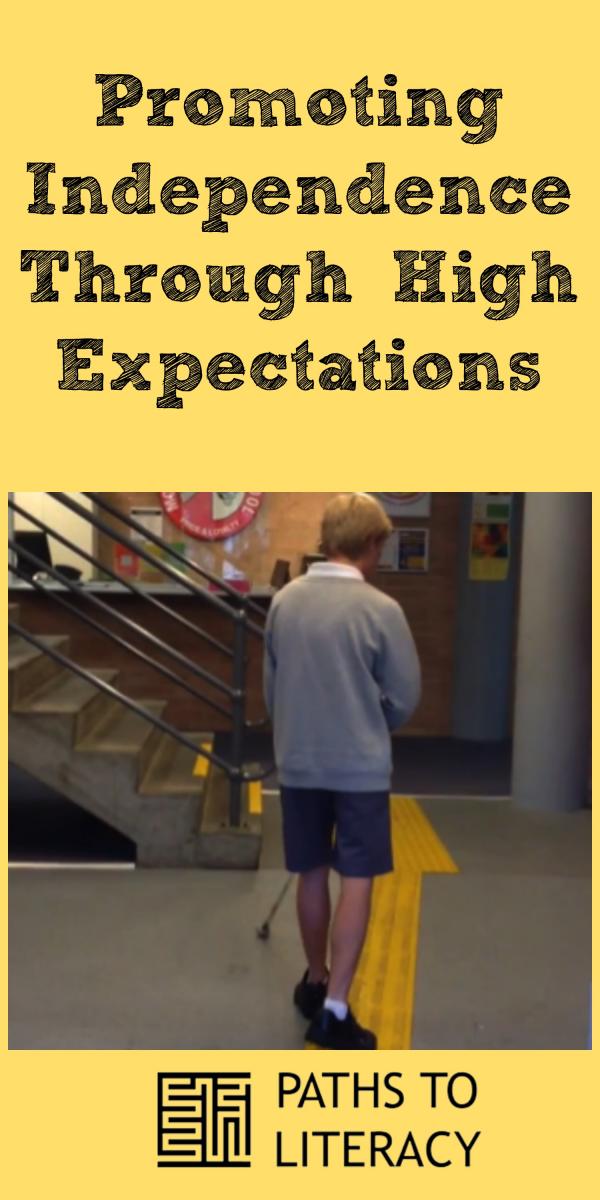Paths to Literacy -- Literally!
It’s amazing how much the example of a competent older student with a vision impairment can impact on all of the outcomes for younger students with vision impairments. And it’s equally amazing how allaying one basic fear in a learning setting can raise the expectations of a whole staff across all areas of school life.
The impact that higher expectations can have on a student’s learning is magnificent.
I’ve written before about holistic approaches to literacy. This article will address the connection between orientation and mobility, student communities and the development of literacy.
Background
Usually, in the areas where I have worked, when TVIs have a new student starting at a school we experience the same concern from school staff. How will she get up the stairs?
I used to be patient with these comments, but these days I have to admit that I’m not.
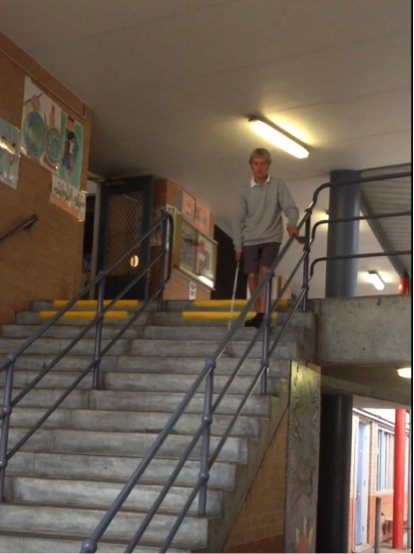
So, it’s very important to dispel the myths early on. If the expectation of a student is that she’ll never be able to move around the school independently, or that all lessons will need to be timetabled on the ground floor, the expectations of her literacy, life skills and learning outcomes will, very often, be correspondingly low.
Walking the Corridors of Learning: How the community of students can make a difference
Over the past few years I’ve been encouraging my students to give back. So much of their lives is receiving assistance, going first, having second chances; there comes a time when doing something for someone else becomes an important next step in becoming independent, seeing themselves as competent, moving towards employment and building equal relationships.
I had also been experimenting with the power of older students to encourage their younger peers to learn, socialise, contribute and succeed. We see this at Vision Camps and I was trying to think of a way to bring that back to school situations.
So, after a student leadership/work skills program we’d been running in our regional vision team, I talked to our older students about possibly speaking to, or making movies for, the schools that our youngest students attend. The older students were eager to be involved.
The aim of these movies would be to inform and reassure educational communities that their students who have vision impairments can engage fully, become independent and participate in the activities and life of the school. They would also provide for our students with VI (and their parents), who rarely meet other students with VIs, examples of people who are like them and are successful.
Then I got a transfer and moved away from that team and those students.
Sam Craft, Orientation and Mobility: The Movie, or, “Bob’s” path to literacy
I started working as Specialist Vision Teacher with a new student, Bob, when he was half way through year 8 (the second of our 6 years of High School). Bob was 14 years old: this is not the best time in any human existence, so starting to work with a student at that point can be a challenge. Bob is blind from birth and has no additional disabilities.
Bob was a disgruntled, disengaged student who could be rude to TVIs and teacher aids, although he rarely spoke to anyone else. As Bob had become used to adults giving his answers, simple questions like "Do you like music?” were met with silence. Bob sat in class doing very little and in Math he put his head on the table and refused to do anything. He repeatedly commented on how much he hated school, hated subjects, and was bad in subjects (this was not true; he’s quite bright). He refused to attempt any assessment tasks.
Bob refused to move independently around the school and even required help to find his seat in class. When moving from room to room Bob moved very slowly and clung to teacher aides, leaning in to them and almost appearing to be dragged along. He left classes 10 minutes early and arrived 10 minutes late.
Many teachers had low expectations of Bob and when he did little in class they rarely realised that he could do more.
When I started working at the school I was given the opportunity to talk to the whole staff in a meeting. I talked about having high expectations and about possibilities. I showed a short clip from a movie from Erik Weihenmeyer. I was met with both hope and disbelief when I talked about my student becoming independent and moving towards the work place.
I started implementing a program to help Bob become more independent in class, spend more time with his peers and move independently around the school. Most of Bob’s class teachers were supportive. Bob did not show a great deal of support and I realised that his belief in himself was quite low.
I would say things to Bob like, “This will help you to move independently around the school.”
Bob would reply, “You’ll never make me do that!”
I’d say, “I know, but I will give you the opportunity.”
In class, when teachers would ask Bob to do something, Bob would reply, “I won’t be able to do that,” or “I won’t be very good at that.” He was also very critical of his peers if they made a mistake, even if they were trying to help him at the time.
Interestingly, in most cases, once Bob had stated his objection to whatever the plan was, he very often tried with great determination to achieve things.
I had been hoping that, like in a movie, Bob would be inspired, realise his potential and become independent and eager to learn in 6 months. That didn’t happen….
He did make some progress, but it was slow and I really wanted a whole school approach to Bob’s development. I wanted people to stop assuming that he couldn’t do things and expect more. I wanted people to stop stepping in to do or say things for him that he could do or say for himself and to reject his claims that he couldn’t do anything. How could I get the message across?
For Bob’s class teachers the clincher came with the Paralympics. I sent links of the TV coverage to all staff and, because Bob was in their class, his class teachers followed the events avidly. Daily they saw people with vision impairments achieve. They literally said to me, “If those dudes can do it, so can Bob.”
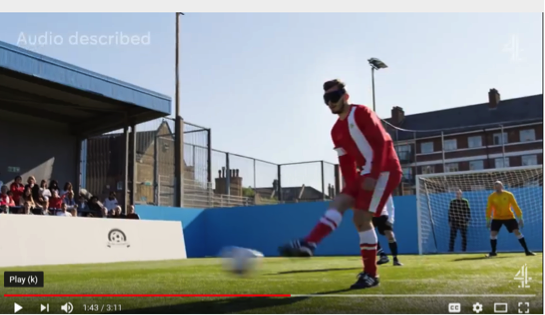
The advertisement for the British Paralympic Team “We are the Superhumans” also appeared on YouTube at that time and I sent it to teachers, who watched it and commented on it. My student watched it a number of times. As I walked around the school I repeatedly heard it being played to classes.
So, luckily for us, the world was in support of Bob’s independence.
I wondered how else I could demonstrate Bob’s potential to the whole staff and thought of one of my ex-students (Sam Craft) who was a few years older than Bob and had been enthusiastic about making videos for his younger peers and their schools. I contacted one of my colleagues (Mandy Huber, Assistant Principal Vision), who still worked with Sam and asked her if she could help me make a film. She said yes.
I sent through a series of questions or topics that I wanted to address. I really had specific needs with Bob, and was able to address all of them by asking Mandy and Sam to produce a movie answering these questions.
Mandy interviewed and filmed Sam (using her iPhone) at his High School and sent the movies to me on a USB. All of the clips were great, each one useful. Because Sam is very funny and charming, I could have used the whole thing. However I know that teachers are very busy, so I edited the movie to make it very succinctly tell the story that I wanted to tell.
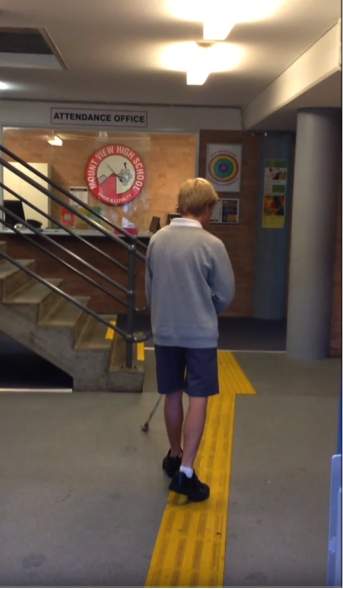
Once again I was able to speak to the whole staff of the High School in a staff meeting. I started with a quick update on Bob’s progress, thanked people for the progress we had made and shared my plans with the staff.
Put simply, I wanted Bob to move independently around the school, so asked staff to trust me to train him and to avoid either “helping” him, or engaging him as he very slowly moved around the school. I reassured them that he would not injure himself, there were tactile markers and other landmarks to assist Bob in his journey, and reminded them that he had had at least 2 hours of O&M training every week for the last 10 years. (To begin with, partly for safety reasons but mostly to relieve the worry of staff members, adults would unobtrusively shadow Bob from a distance to ensure his safety, but he never needed them.)
I wanted teachers to have the same expectations of Bob that they had of his peers in class. I asked them to produce material in accessible format, or get it to me in an appropriate time so that I could modify it. I asked them to impose the same consequences on Bob when he didn’t do his work as they imposed on his classmates.
I wanted Bob to have access to his peers, so asked adults to step back, to let him be alone sometimes, to allow his peers to get closer to him.
I talked about all of these aims with reference to Bob moving towards a workplace, moving out of home and building relationships as an adult.
I asked staff to support me and Bob and talked about our end aims. Then I asked them to watch the movie, “Sam Craft: Orientation and Mobility”.
Download the transcript of the video.
Watching the movie, teachers responded very positively, laughing at the funny bits and applauding at the end.
Over the next few days many teachers spoke to me about the movie and how it had impacted their view of Bob. They thought that if Sam had achieved these things, then Bob could too. Their idea that Bob’s behaviours were caused by his blindness were challenged by seeing another student who is blind being charming and engaging, talking about his success as a student, and enjoying life.
I can say without exaggeration that this movie made a very powerful impact on the people who saw it and from that time I saw higher expectations of Bob across the school.
I talked to Bob about him moving by himself around the school. Once again he said, “You can’t make me do that,” and “I won’t be able to do that.” I really didn’t know what would happen, but with the whole school support, and with Bob’s usual determination, within a week he was moving independently from class to class very slowly and he was leaving class at the same time as his peers. Within class he could find his seat and get his own equipment.
As time went on, teachers continued to refer to Sam’s movie and use that as a reason for their expectations that Bob would do well. Class teachers clearly considered Bob and how he would learn, and often came to me with ideas of how Bob could access learning in interesting and engaging ways.
I was also able to show the movie to Bob and the students in some of his classes. Bob saw the movie 3 times in various classes and I could see that it had an impact on Bob and his peers. I sent a link home to Bob’s parents.
I would like to say that, like in the movies, Bob changed immediately and was happy and cheerful and did all of his work. That’s not true. However, almost all of the staff at the High School did understand that Bob had great potential and could do more. And Bob certainly improved in his movement, school work, connections with peers and general happiness.
Bob’s Path
Over the next 3 years, the staff have had a unified goal that Bob would move towards achieving his potential. Not only his class teachers, but all staff, have believed in him and enabled him to develop. So many people have done so much on his behalf. It’s been wonderful to be part of this dedicated group and to see their work and belief having such a positive influence on my student.
The teachers’ behaviour has had an impact on other students too. Students take their cues from teachers, so they also have higher expectations of Bob. They see him more as an equal than as someone who needs to be looked after.
Led and mentored by 2 teachers who are their year advisors, as well as class teachers and executive staff, Bob’s whole year group support his development and independence. They are a lovely group of young people and Bob has benefited enormously from being treated as an equal.
Bob has developed in all aspects of his social and academic life. He now moves independently and confidently, has conversations with his peers and adults, enjoys spending time with others, is interested in the world, tries hard at many things and is engaged in class. When things are on at school he makes an effort to be involved and he has real friendships. Generally speaking, Bob is happy.
In class Bob does his work at a similar rate to his peers and in some subjects he is doing quite well. He has presented a number of speeches in various classes. In year 11 he changed from using a BrailleNote to laptop computer with screen reader, and is doing this quite cheerfully.
Bob went to year 9 camp unassisted. I went on the first day to orient him and after that he was independent or supported by his peers. He independently organised to go to the year 10 formal. In year 10 Bob participated in a work training program where he and a small group of other students caught the bus to Ronald MacDonald House one morning each week to prepare lunches and a dessert for the people staying there.
Bob has taken part in a project we have where older students read kindergarten books in films for our younger students with vision impairments to use in their classrooms, and, while he had to be convince by his year advisor to make the first film, he is now happy to read whenever he is asked.
This year Bob is studying practical subjects, such as Hospitality, Retail Studies and Timber Technology (woodwork), as well as English, Modern History and Biology. He goes to the local mall with his peers during Retail classes and is learning a great deal there. In woodwork he has made a box for keepsakes and is working on a cheval mirror with 2 drawers. In Hospitality he cooks in a group with his peers and is doing well at most things, except presentation of dishes. He recently completed a block of work experience at the Blind Chef Bistro (a business which, as the name suggests, has a chef who is legally blind).
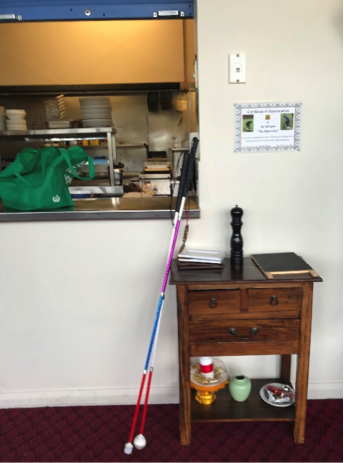
People say that it takes a village to raise a child. In this case, it takes not only a school to educate a student, but also his wider Vision Community to help him travel on the path that will be most beneficial to him.
Bob’s physical path, his independence of movement, was very closely linked to his development of literacy, numeracy and learning. "Sam Craft: Orientation and Mobility" was a first very big step on the path to independence in both movement and learning and I’m very happy that Mandy and Sam agreed to help us in this way. It’s been a wonderful experience to work in a school environment that has been so willing to support a student with Vision Impairment and to believe in his abilities. The whole school community has worked together with cohesion and determination to help Bob develop to this point.
There have been many other significant turning points in Bob’s development, some I’ve written about already on Paths to Literacy and I hope to write about others in future articles. However, this movie was an essential part of the first major point of change and had a most profound impact on Bob’s learning environment and on his path to independence.
Student Leaders: Giving Them a Chance
While I haven’t dealt with it in this article, I think Sam’s involvement is also an example of how enabling students to have the opportunity of leadership can benefit them. Among other things, it enabled both Sam and others to see him as a leader in his community and as he left school it could be used in his CV as an example of the way that he had volunteered in his community. It helped Sam and his teachers evaluate and understand how much he had achieved in his years at High School. I’ve shown this movie to more than one group and have always shared with Sam the positive responses that he receives. He is proud of the results of his efforts, as he should be (and a little bit famous).
